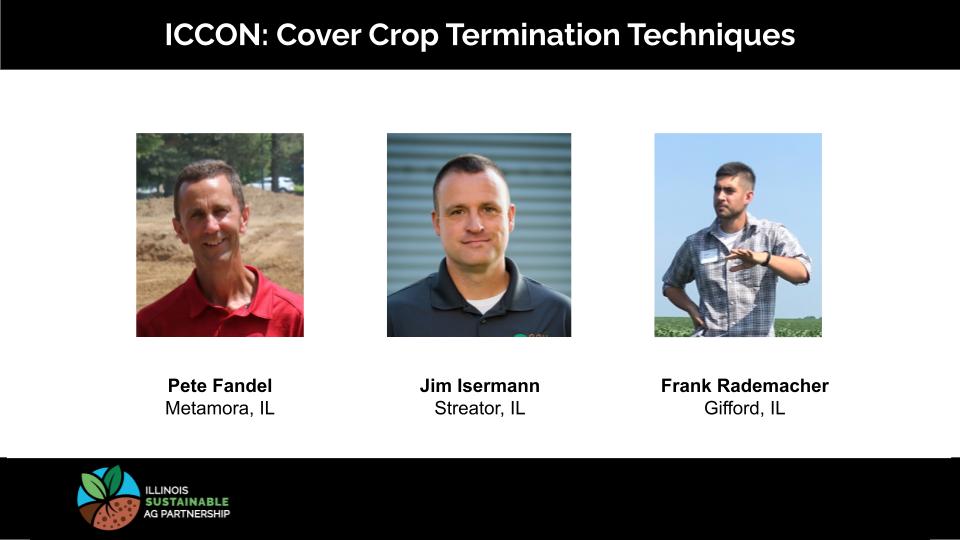During ICCON’s March cover crop call, the Network hosted a panel of cover crop farmers who shared their strategies for cover crop termination and how covers are used as a management tool for their cash crops. Three Central Illinois farmers – Jim Isermann, Pete Fandel, and Frank Rademacher – gave an overview of their operations, presenting three models for how to successfully terminate cover crops.

Pete Fandel
Pete Fandel is a farmer near Metamora, Illinois and an agriculture professor at Illinois Central College, where he conducts cover crop research. Pete has been using cover crops on his home operation for nearly 14 years. Ahead of his soybeans, Pete typically uses 1 bushel of cereal rye and 4 lbs. of rapeseed applied aerially in September. He will usually terminate chemically with Glyphosate plus a residual product less than 7 days before planting, or he will plant green and terminate several days after planting.
Ahead of his corn, Pete runs winter barley or triticale with 4 lbs. of radishes seeded aerially in mid-September. This means that he is often clipping the tops of the cover crop with the combine during soybean harvest, but this does not present any significant harvest issues or hurt the cover crop. Pete’s spring termination is done with glyphosate ahead of planting followed by a light tillage pass immediately ahead of the planter. Pete attributes this tillage pass to providing a quicker breakdown of the cover crop residue and less early season nitrogen tie up.

Isermann Farms, in Streator, IL, began using cover crops as livestock forage after starting a livestock heard in the early 2000s and have since integrated the use of cover crops on their corn and soybean acres.
Jim Isermann
Jim Isermann farms in Streator, Illinois and is a Soil Health Specialist with the Illinois Sustainable Ag Partnership. Jim and his dad began incorporating cover crops into their operation primarily as a means of providing forage crops to livestock, and the system has evolved to using covers in their corn/soybean/wheat rotation over the years. Jim utilizes a custom applicator for terminating their cover crops. He targets cereal rye termination at about 18-24 inches. Typically, termination occurs prior to soybean planting. Jim has planted green in the past but usually likes to have the cover terminated first. Jim is a strong advocate for keeping the system flexible and being willing to adapt to conditions, emphasizing that “every year is different.” He has seen significant weed suppression in this system and emphasizes that he would much rather have to kill 18-24” cereal rye that is easy to kill than try to battle 8-24” marestail or 6+” water hemp in season.
Jim has utilized annual ryegrass in a strip-till system ahead of corn. This sometimes adds a layer of complexity but can work very well when managed properly. Prior to incorporating cover crops into the corn system, he would apply nitrogen with the spring burndown herbicide pass. With cover crops in the system, he stresses the importance of moving that nitrogen from the burndown to the planter. Nitrogen with the cover crop termination pass can cause insufficient translocation of the glyphosate and result in poor control of the cover crop. Planter applied N is also in a better location to be utilized by the early season corn seedling.

Frank Rademacher planting corn into a stand of hairy vetch and cereal rye in mid-May.
Frank Rademacher
Frank Rademacher is a Conservation Agronomist with The Nature Conservancy and farms about 600 acres with his father in Champaign County, Illinois. The Rademachers run an all corn and soybean rotation, typically with specialty crops- non-GMO and food grade. They utilize cover crop mixes and will typically terminate with a combination of a chemical pass and planter mounted roller crimping. This means they are planting green and termination is occurring during and immediately following planting for both corn and soybeans. This has been a very efficient system for the Rademachers and usually takes place in mid-May. Because of the later termination, the cereal rye is in its pollination phase and can create some issues with the radiator and air filters on the planter tractor. To solve this issue, the Rademachers have constructed a shield to help deflect and protect the engine compartment from the pollen clouds created by the rye.
All three presenters indicated that they rely on glyphosate as their primary cover crop termination herbicide and also include 2,4-D when necessary to control other broadleaves in the mix. All three farmers on the panel also agreed that they much prefer the challenge of cover crop termination compared with trying to control difficult weeds during the growing season that may be herbicide resistant. Looking to the future, all three presenters are looking for ways to tweak their systems to improve performance. Potentially experimenting with new species or making changes to equipment are just a couple of the areas that can have significant impacts moving forward. As with any management change, it is best to crawl before you walk and walk before you run. Make small changes and figure out what works on your fields before going all in.
ICCON’s April call will feature a legislative update on policies and funding programs related to conservation practices as well as the 2023 Farm Bill. If you are interested in joining the Illinois Cover Crop On-Farm Network to learn about new research and hear from cover crop specialists across the Midwest, you can register for our monthly calls or join our google group by sending an email to hvanbeck@farmland.org.